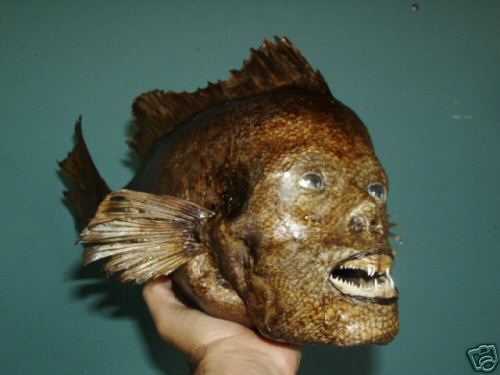
Human-faced fish “Lasirenn” (2006). Image: Juan Cabana. All images used with permission of the artists; do not reproduce without the artists’ written consent.
Beady glass eyes stare forlornly, dismembered limbs are strewn around and a faint smell of formalin hangs in the air. This is how many would picture the studio of a taxidermist, and they might not be so far off. However, the objective of taxidermy has changed. Whereas it was once purely about the preservation of dead animals in order to make them appear to be as lifelike as possible, the new goal of artistic taxidermy is to create something unique. The results of this new art form are fantasy animals and hybrid creatures — some cute, some gory.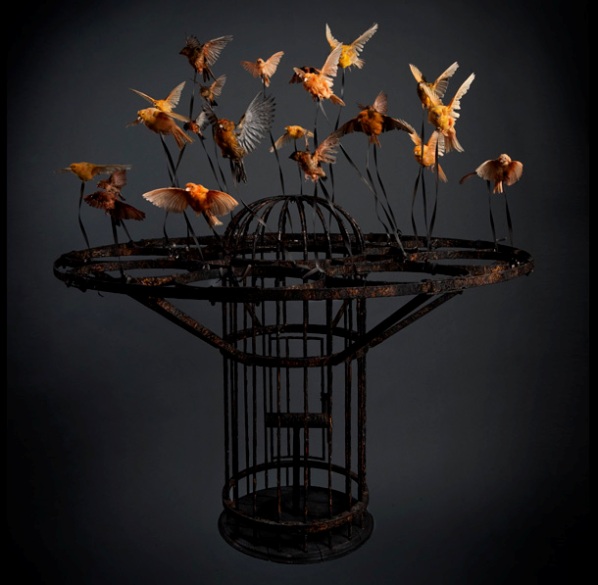
“Systemic Inflammation” (2010). Image: Polly Morgan
The seven taxidermy artists whose work is illustrated here create their individual pieces because they are fascinated by death and because they love animals. In fact, most of them are staunch animal rights activists. They make sure to only use animals that have been brought to them by friends, colleagues and other sources, or those animals that are the victims of road accidents or those that died a natural death. If this wasn’t enough recycling already, most of the artists also make sure to use each and every part of the animal. 7. Sarina Brewer — Custom Creature Taxidermy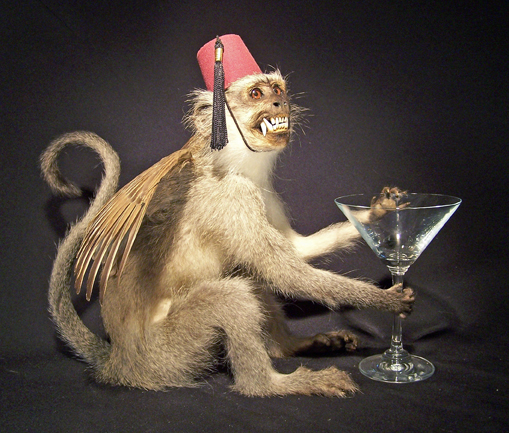
“Mother’s Little Helper Monkey.” Image: Sarina Brewer
Sarina Brewer sees herself as an artist and naturalist who “recycles the natural into the unnatural, breathing new life into the animals she resurrects.” And what fabulous animals she creates: griffins from various eras, winged cats, vampire squirrels and many more fantasy creatures that are a bit scary yet strangely fascinating.“Capricorn”
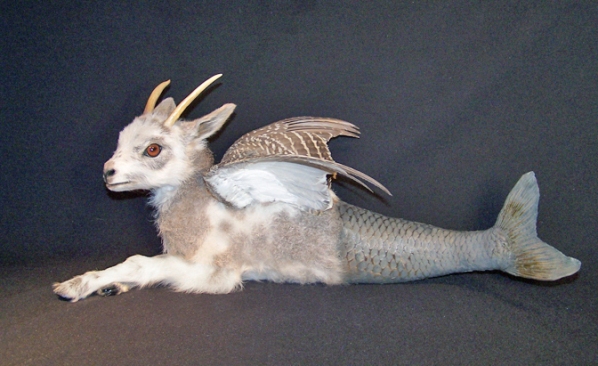
Image: Sarina Brewer
Talking about her work, Brewer explains: “I deal with death, in what is considered by most, an unconventional manner. I do not view a dead animal as disgusting or offensive. I think that all creatures are beautiful in death as well as in life, beautiful on the outside as well as on the inside. I pay homage to them by reincarnating them in my work, creating life where before there was only death.”“Goth Griffin”
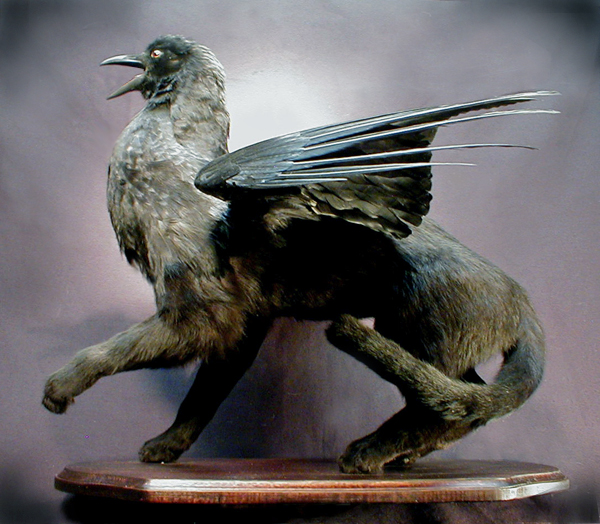
Image: Sarina Brewer
Brewer combines her passion for science and animals in her taxidermy creations. She also participates in various natural history projects for educational institutions and museums like the Science Museum of Minnesota. Together with colleagues Robert Marbury and Scott Bibus (featured below), she founded the Minnesota Association of Rogue Taxidermists (M.A.R.T) in 2004. A strong proponent of wildlife conservation, she follows the “waste not, want not” approach in her work. Thus, throughout her career, a primary directive has been to use only ethically procured animal materials, a chief source being roadkill. Out of respect for the animals, she wastes as little as possible. As one can see in the artwork below, which utilizes squirrel carcasses, virtually every part of the animal is recycled in some manner.“The Main Event”
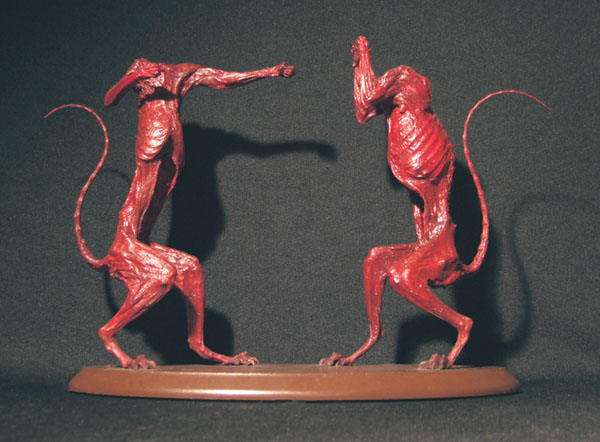
Image: Sarina Brewer
“Bast” below is one in a series of gold-leafed animal mummies (in this case a gold-leafed cat mummy with dove wings), which is probably Brewer’s most recognizable homage to animals. Straightforward as the sculptures are, they put Brewer’s work into context.“Bast”
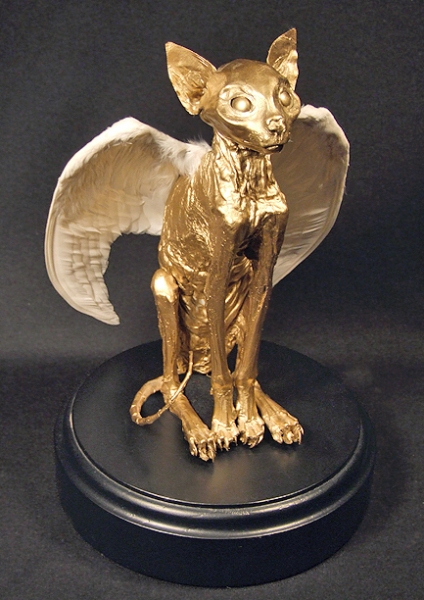
Image: Sarina Brewer
Brewer is an internationally recognized artist who has been recycling animal materials into art for 20 years. She received formal training at the Minneapolis College of Art & Design, earning a Bachelor of Fine Arts degree in 1992. Specializing in creating fanciful composite beasts, her eccentric taxidermy sculptures reside in prestigious collections around the world, including the Geneva Museum of Natural History in Switzerland. Make sure to take a look at her impressive body of work on her website, also the place from which to order artworks, ranging from $20 to $2,000 and up. 6. Iris Schieferstein — ” …the longer you are dead”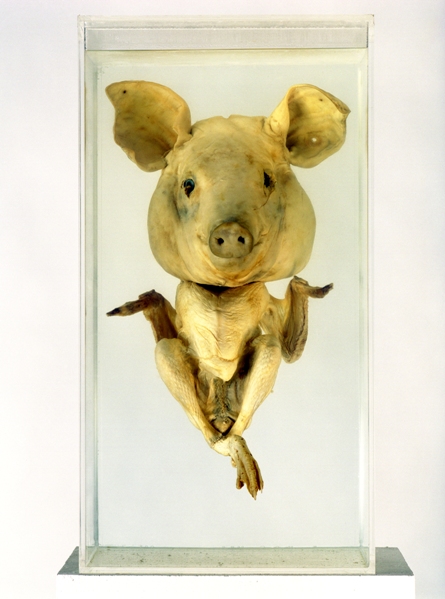
“Maria” (1999). Image: Iris Schieferstein
According to her motto, “the earlier you die, the longer you are dead,” German artist Iris Schieferstein (pronounced Sheefah-shteyn) sees taxidermy as an opportunity to recreate, forming completely new creatures from different animal parts, thus giving them a new face after death. “It’s a bit like playing God,” she says. Frankenstein is the association others draw from her work.“Chandelier” (2005)
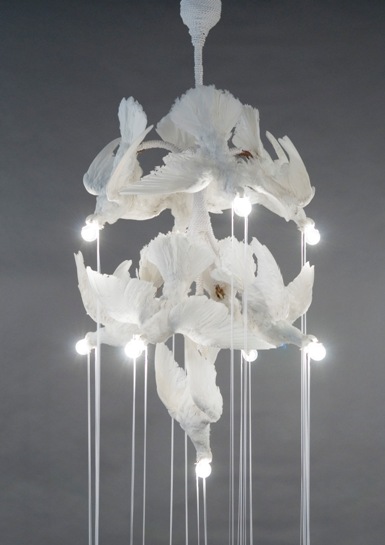
Image: Iris Schieferstein
Even at the Arts Academy in Kassel and later in Weißensee, Berlin, where Schieferstein studied fine arts from 1989 to 1996, her professors thought she was crazy when she presented her first taxidermy sculptures. In fact, “they almost fainted,” Schieferstein recalls. Her fascination with taxidermy developed from an early exposure to death after visiting her mother, a nurse, in hospital, and a morgue while at art school.“Snake Pistol” (2007)
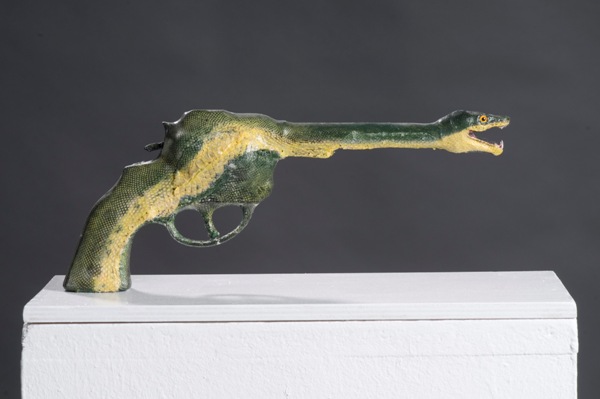
Image: Iris Schieferstein
Her work “Horse Shoes” (below) created a particular outcry over its alleged cruelty. It thus holds a mirror in front of the viewers by questioning what is fashionable.“Horse Shoes” (2008)
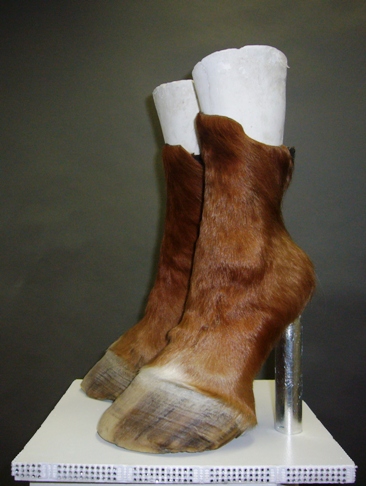
Image: Iris Schieferstein
Like the other taxidermy artists featured here, Schieferstein uses only the remains of already dead animals and sources them from friends, neighborhood butchers and other taxidermists. Make sure to visit Schieferstein’s website for more of her work, or go to the Abnormals Gallery in Poznan, Poland, which is hosting her work this November. 5. Julia deVille — Disce Mori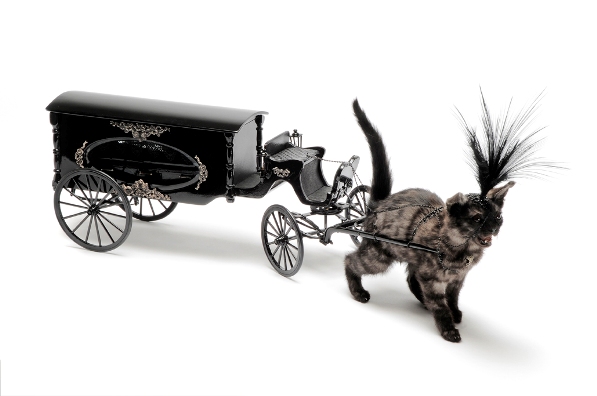
“Kitten Drawn Hearse” (2010). Image: Julia deVille
Julia deVille’s taxidermy creations seem to have sprung to life from fairy tales. There’s the clever raven, the enchanted deer, the lucky goose and many others. Only, they’re not alive, merely frozen in time. Talking about her choice of topic, deVille explains: “I am fascinated with the aesthetic used to communicate mortality in the memento mori period of the 15th to 18th centuries, as well as the methods the Victorians used to sentimentalize death with adornment.”“Lenore” (2010), the spotted deer, seems to be an enchanted princess, here catching a nap
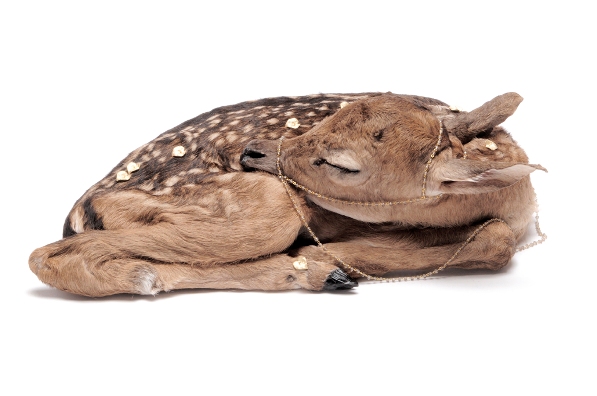 Image: Julia deVille
Image: Julia deVille
The talking raven, caught mid-flight — “Psychopomp” (2010)
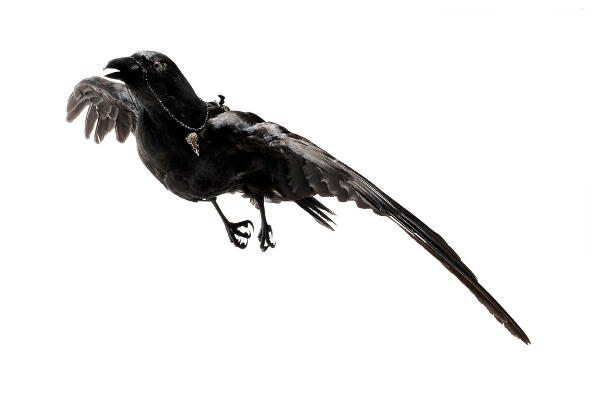 Image: Julia deVille
Image: Julia deVille
Touch me and you’ll become rich and pretty — “Golden Gosling” (2010)
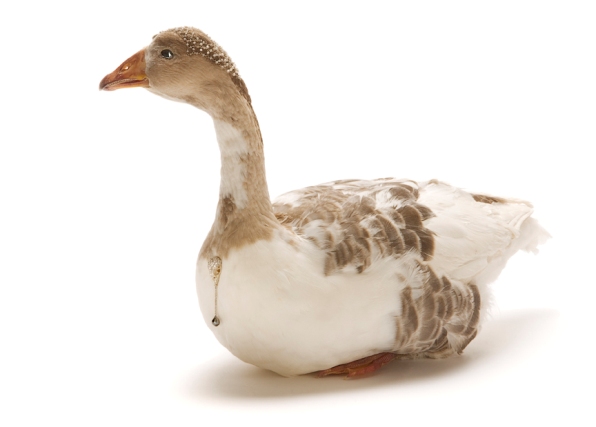
Image: Julia deVille
Like all the artists featured here, deVille feels “strongly about the fair and just treatment of animals,” and makes it a point to only use animals that have died of natural causes. The New Zealand-born and now Melbourne, Australia-based artist is so serious about her art that she has promised her own body after death to Germany’s renowned Institute of Plastination, where it will be dissected, prepared and preserved for exhibition.The valuable piglet, weighing in heavy — “Orcus” (2010)
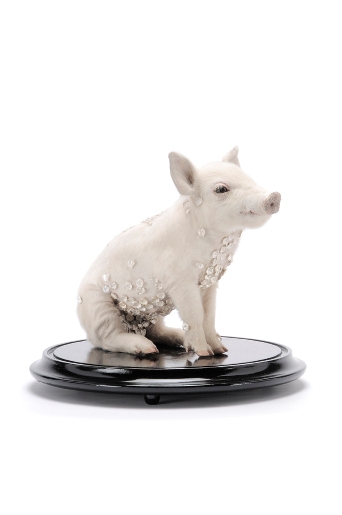
Image: Julia deVille
Make sure to check out deVille’s amazing website. Not all of the very latest creations featured here are available yet, but you’re sure to find many fascinating pieces. 4. Polly Morgan — Enter at Your Own Risk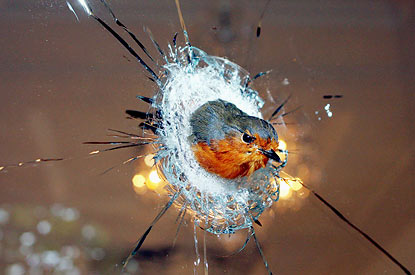
“Robin.” Image: Polly Morgan
Polly Morgan is upfront about her art and her passion: before you even enter her website, you see a message that all animals used in her art have succumbed to either natural or unavoidable deaths and that she is a member of the Guild of Taxidermists — all of whom adhere strictly to the guild’s rules. For those upset or offended by the sight of a dead animal, she recommends not entering the site.“Atrial Flutter” (2010). A bunch of colorful balloons are carried by a bright red cardinal that seems to be trapped in a partial skeleton.
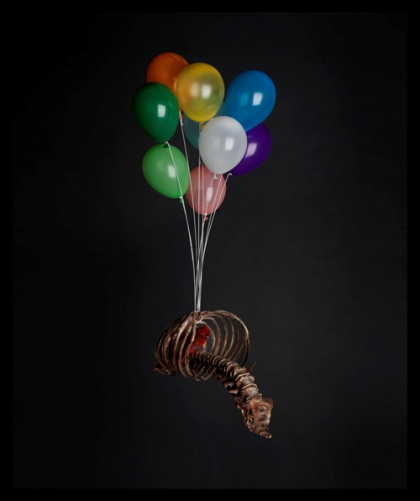
Image: Polly Morgan
Well, we surely did enter and are glad we did so, because we found a treasure trove of information and unconventional art. With her still lives, Morgan forces the viewer to take a second look. What looks like an innocent flower arrangement from afar turns out to be a sculpture made out of dozens of crow wings — literally a bunch of birds.“Black Fever” (2010)
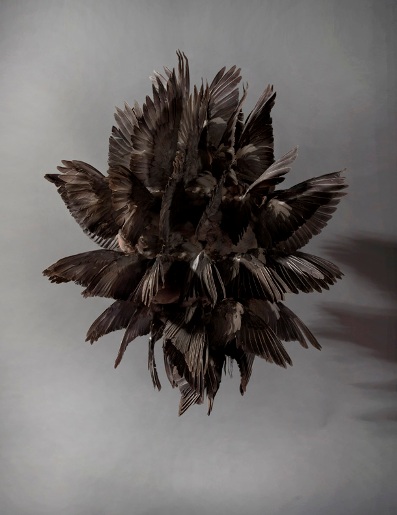
Image: Polly Morgan
Taking these animals out of context or even out of place is done on purpose by Morgan, who wants to “encourage us to look at them as if for the first time.” Thus, she says on her website, “a rat sheds its association with horror and disease and can be rightly viewed as a beautiful animal.”“Feed Me” (2010)
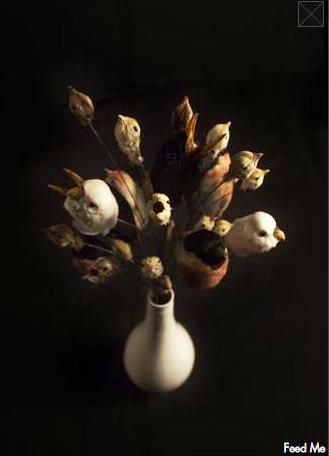
Image: Polly Morgan
London-based Morgan began working as an artist as late as October 2005, but her still lives have been an almost instant success. Her love of animals and a desire to preserve them led Morgan to study taxidermy under George Jamieson. Those who’d like to see an exhibition can do so at the current “Contemporary Eye” at Pallant House Gallery in Chichester, England (through March 6, 2011). 3. Pascal Bernier — Hunting Accidents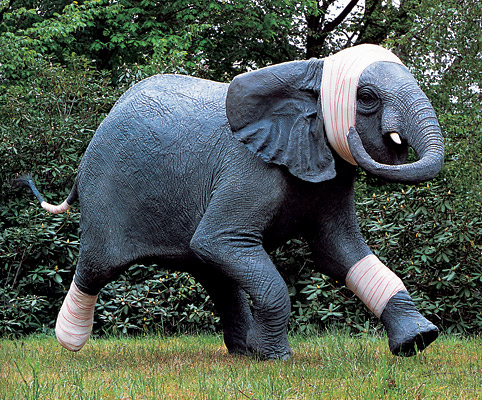
“Elephant” (2000). Image: Pascal Bernier
With their bandaged paws, heads and legs, Pascal Bernier’s creations immediately evoke pity from viewers. Only later do we realize that our sympathy is uncalled for, as the animals are long dead. But Bernier doesn’t let us off that easily. His series “Accidents de Chasse” or “Hunting Accidents” (1994-2000) points us to the unnecessary practice of hunting trophies.“Wild boar” (1997)
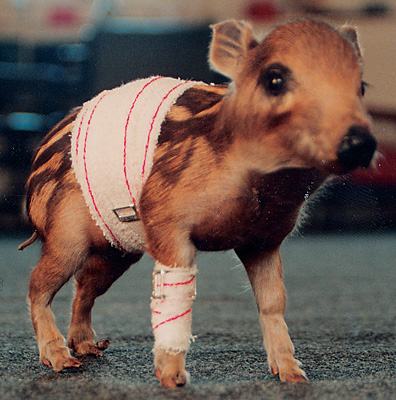
Image: Pascal Bernier
Bernier explains the idea behind the series: “For time immemorial, one of the leading questions that humanity has asked itself is: ‘What’s to be done with the body?’ Hunting trophies, unlike mummies, are in no way a preparation for a journey into the afterlife. At best, they crystallize the glory of the hunter who imposes immobility on the living creature, reducing it to its image. At worst, they become decorative objects devoid of meaning. Only art will enable the animal (posthumously) to sell its skin for a high price.”“Deer” (1996)
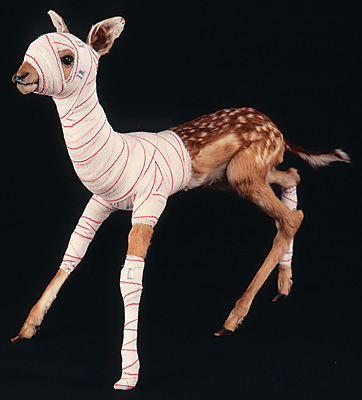
Image: Pascal Bernier
Brussels-born and based Bernier shot to fame with his solo exhibitions in the early ’90s, first in Belgium, France and the Netherlands, and then worldwide.“Lion cubs” (2007)
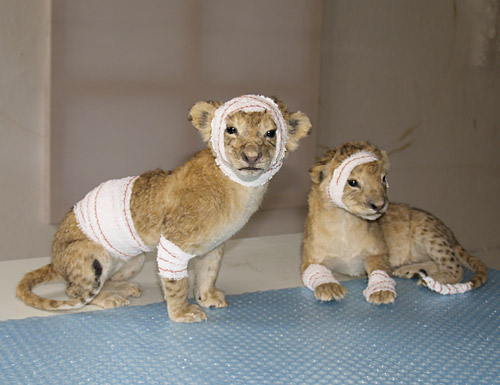
Image: Pascal Bernier
Apart from taxidermy, the versatile artist also focuses on the “Lost Innocence” of childhood in a series of repurposed toys. Recent works have included skeletons, snails and insects, of which you can see more on Bernier’s website. 2. Scott Bibus — Dead Animal Art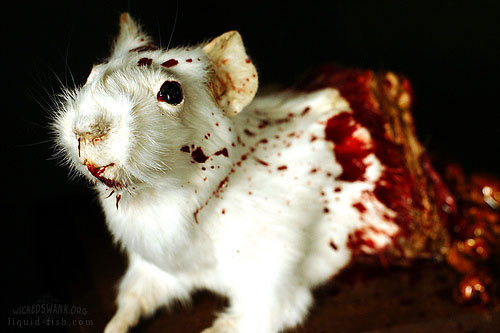
“Zombie Guinea Pig.” Image: Scott Bibus
One could say that Scott Bibus has come furthest from “traditional” taxidermy, as very few of his creations are lifelike or even whole. What Bibus recreates could often best be described as roadkill or an animal’s zombie avatar. For example, he says of the piece below: “This tribute to insanity sits 7 inches tall and is made from an actual, genuine muskrat! It features one beady yellow eye and a malicious grin. Gaze into the mouth of madness! MUSKRAT MADNESS!”“Maniacal Mutant Muskrat Taxidermy”
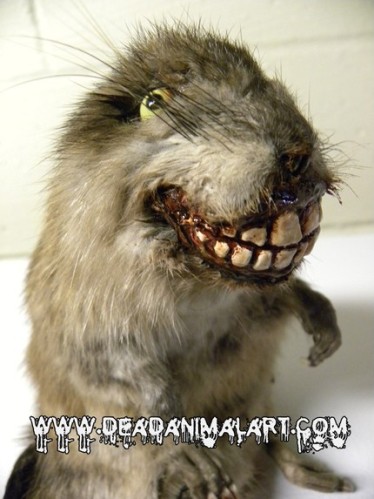
Image: Scott Bibus
Like most taxidermists, Bibus is fascinated by death and explores the human relationship with it through taxidermy. His website explains: “By blending the death-concealing techniques of taxidermy with the exaggeratedly grotesque aesthetics of horror movies, Bibus creates totems to the human defense mechanisms developed in the face of our own mortality.”“Parrotfish Cocktail”
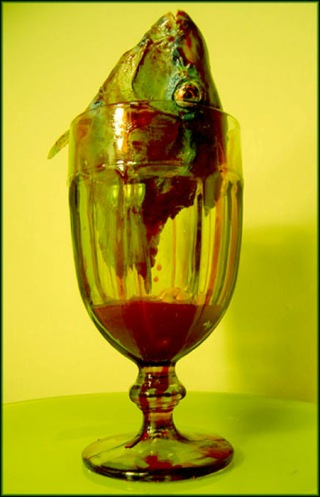
Image: Scott Bibus
Though his pieces often look gruesome, Bibus assures us that no animals were harmed in their creation. In fact, as a co-founder of the Minnesota Association of Rogue Taxidermists, he makes sure that all animals are procured either as roadkill, were donated after natural deaths or were sourced from veterinary clinics and grocers.“Three-armed Squirrel”
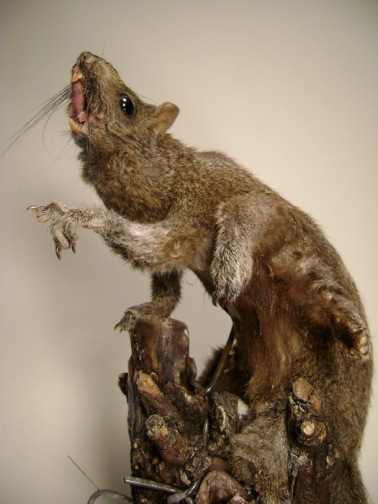
Image: Scott Bibus
Bibus came to taxidermy after a degree in English literature from Augsburg College in Minneapolis. He then trained in traditional taxidermy and has never looked back since. For more of his art, or to buy any of his pieces online (ranging from $20 to $750), make sure to visit his website. 1. Juan Cabana — Remember the Feejee Mermaid?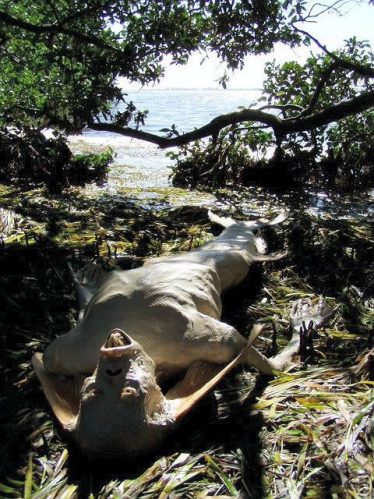
“O Cruel Sea” (2006). Image: Juan Cabana
Tampa Bay, FL-based taxidermist Juan Cabana specializes in aquatic fantasy creatures that range from a few feet tall to merely a few inches in size. For all of them, he uses authentic fish skin, fins and teeth. The fascinating thing about Cabana’s sea creatures is that, photographed in context, like “O Cruel Sea” (2006), above, and “The Dead Sea” (2007), below, they look surprisingly real. If caught unaware, you could be convinced that you had stumbled upon a new sea species or even a mermaid. In fact, Cabana receives emails from around the world wondering if the photos on his website show authentic mermaids and sea monsters.“The Dead Sea” (2007)
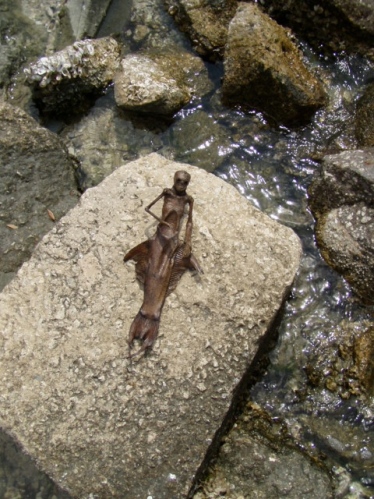
Image: Juan Cabana
Talking about Cabana’s art, Kim Bannerman says: “Cabana’s mermaids are no gentle pre-Raphaelite maidens. These mermaids seduce us, not with their siren beauty, but with parchment skin and haunted eyes. Their allure lies in their hypnotic honesty. Cabana’s mermaids have been dredged from the stygian depths, where the pressure and endless darkness breed spine-toothed monsters and grotesque simian scavengers.”“Pischomina Nympha” (2005)
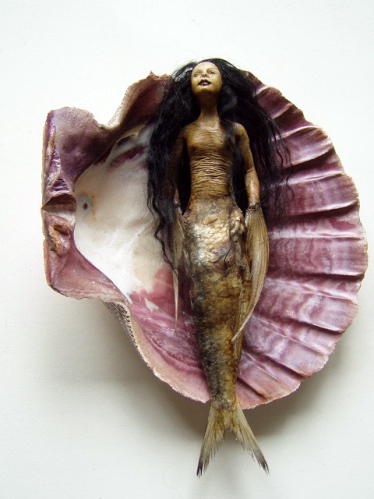
Image: Juan Cabana
In an interview with Environmental Graffiti, Cabana explained the motivation behind his creations: “I was always attracted to strange creatures. Later I became obsessed with the reported accounts of mermaids and sea monsters as described by sailors around the world. I believe we humans evolved from a yet-to-be-discovered ancestor that lived in the sea. We are created in a watery environment and our blood is like salt water.”Flying one-eyed sea monster “Skyfish” (2005)
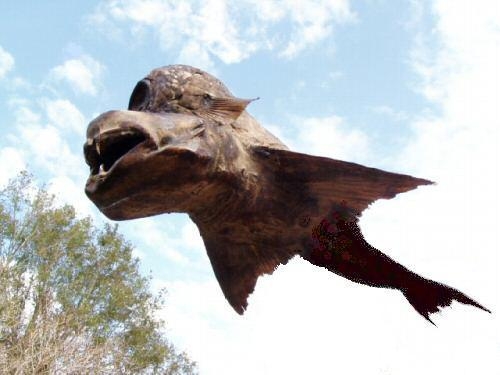
Image: Juan Cabana
Make sure to check out Cabana’s website for more aquatic creatures and purchase information. As we have seen through the seven talented artists featured here, taxidermy can be terrifying when it wants to be, but the art is essentially a celebration of life and the many possibilities it offers — with recycling close to its heart. Special thanks to Pascal Bernier, Scott Bibus, Sarina Brewer, Juan Cabana, Polly Morgan, Iris Schieferstein and Julia deVille for providing information and images and granting us permission to use them in this article. Sources: 1, 2, 3, 4, 5, 6, 7, 8, 9, 10